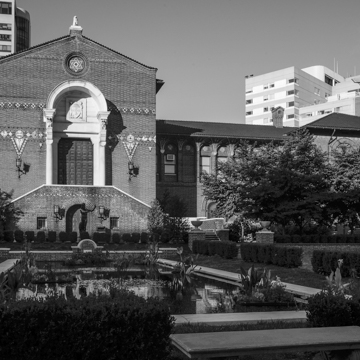Designed by the young teachers of Penn's architecture department, the museum is a memorable synthesis of medieval and Middle Eastern styles with Arts and Crafts accents. The first scheme—a conventional marbleclad, Roman classical design—was quickly dropped for a far more sensitive brick building that complemented the new directions of the campus under Provost Charles C. Harrison. Of particular note is the architects’ adaptation of the conventional Flemish bond, here with paired stretchers tied together with red pointing, giving the illusion of oversized Roman brick. The use of brick tied the building to the university's late-nineteenth-century assertion of its campus identity. The present building is less than a third the size of the most ambitious scheme that called for three courtyards fronting Spruce Street, and an alternate scheme would have added another set of courtyards to the west with three immense rotundas between the two sets of wings. The vast scheme reflected an intellectual organizational framework in which each court was intended to encompass a continent—initially Africa, Asia, and the Americas, and each rotunda would have represented the major civilization of the continent.
The building was designed so that it could be enlarged as the collection and the funding sources grew, beginning with the Lombard Romanesque entrance and flanking wings of the western courtyard, followed by the rotunda with its Guastavino tile vaults, and then the eastward wings, one of which was intended as the new main entrance, but the grand connecting stair was never built. In 1968, Mitchell/Giurgola Architects added the academic wing that connected the deadend corridors of the 1925 phase. It has been followed by the sympathetic, though slightly out of scale, Collections Wing of 1999. Until recently, the main entrance was through the Japonesque entrance gate and into the serene west courtyard. That courtyard has been sadly disfigured by Dagit Saylor Architects to create workspace belowground with a glass tutu of skylights surrounding the perimeter of the building. Within are some of the most remarkable treasures of the ancient Middle East including the Ram in a Thicket and other highlights of Penn's 1880s excavations in Sumeria. What were originally intended as archaeological and anthropological collections now form a global tribute to human ingenuity.











